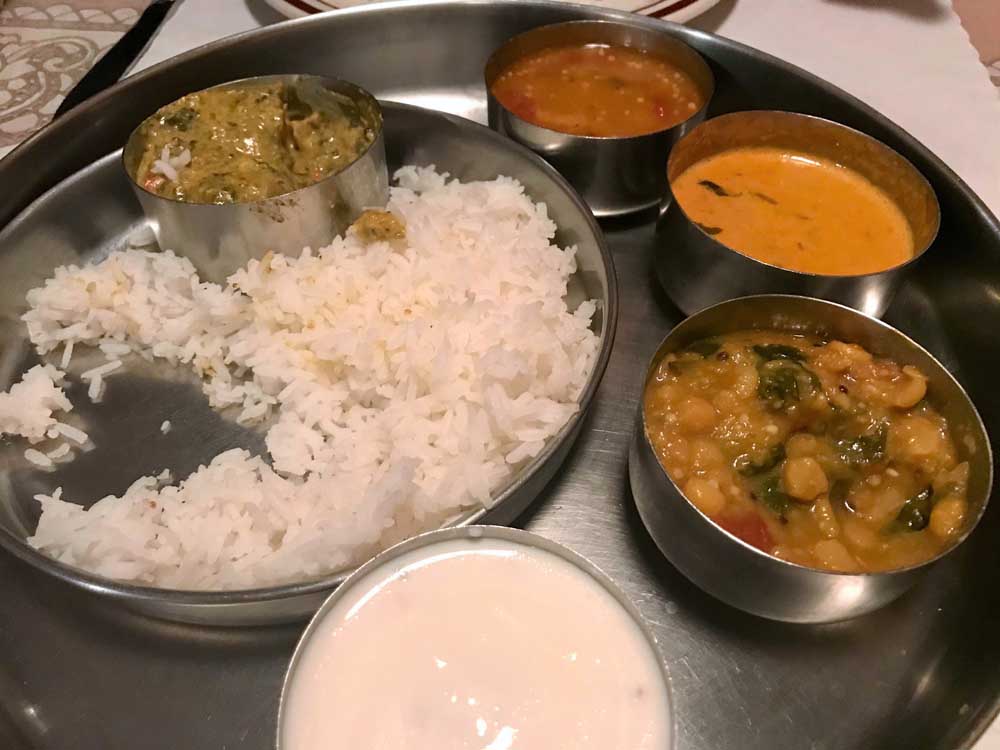Restaurant review: Taj Palace
Published 12:00 am Thursday, March 7, 2019

- The navratan korma dinner entree at Taj Palace in downtown Bend. (John Gottberg Anderson/For The Bulletin)
You know when you’ve dined at a good Indian restaurant.
Hours after a meal, scintillating flavors of coriander, cumin, turmeric, cardamom and other exotic spices continue to ricochet between your tongue and your palate. Tandoori oven-baked chicken, marinated in yogurt and cayenne pepper; lamb stews seasoned with garam masala; creamy coconut milk curries; even lentil dhal slow-cooked with ginger and bay leaves — all of these tastes leave indelible impressions.
Trending
That’s not what you’ll get, however, at Taj Palace, Bend’s leading Indian restaurant since 2003 and, for much of that time, Central Oregon’s only purveyor of South Asian cuisine. (Its primary competition, Mantra Indian Kitchen, opened in mid-2017.)
Taj Palace is merely adequate. Some of its entree dishes, individually prepared, can hint at the full-bodied tastes I’ve found at some restaurants in metropolitan Portland. Others do not. I miss the distinct tang of ginger, garlic, chilies and cloves. It’s as if the Taj chefs are going out of their way to simplify their cuisine for a less-than-daring patronage.
I can’t recommend the daily lunch buffet, even though it’s one of downtown Bend’s best midday bargains ($10.95 for all you can eat). It does offer many meatless choices for vegetarian diners.
But I note improvement in the menu-driven dinner menu. Several dozen entrees can be ordered a la carte, or as part of a thali combination plate.
Service and mood
There isn’t much in the way of ambiance. A soft-spoken host directs arrivals to a booth or table, follows with a pitcher of ice water, then offers menus (in the evening) or points them wordlessly to the buffet (at lunchtime). On both of my recent visits, he was also my lone server.
Trending
The mood is dimly lit, despite lamps that hang above the artificial flowers on each table. Wood paneling covers the lower portion red brick walls that surround the dining room along with artists’ depictions of traditional Indian folkloric tales. Festive ornaments, typical of the autumn Hindu festival of lights, hang from the ceilings, and gentle music plays nonstop.
Midday service is little more than offering beverages, refilling water glasses and removing finished plates while diners return to the buffet for a second helping.
In the evening (the buffet ends at 2:30 p.m., and dinner isn’t offered until 5), the server has a little more to do. He hovered needlessly over my companion and I as we contemplated our menu selections, yet he twice had difficulty in understanding or answering basic questions about the food.
Lunch buffet
There are a couple dozen items on the self-serve lunch buffet, starting with a choice of steamed white rice or fluffy yellow lemon rice cooked with bay leaves. Deep-fried spinach-and-onion pakoras, a popular northern Indian appetizer, were smothered in far too much chickpea dough for my taste.
Dhal, a split-lentil stew, is common throughout India. In the buffet, it was offered with spinach, which I enjoyed, and with zucchini and onions, which didn’t work as well and was thin. Sambar, a lentil-and-tomato soup, was also too thin and mildly flavored.
Indeed, thin consistency extended as well to other buffet offerings, including chana chole (an eggplant-and-garbanzo curry) and mushroom masala (cooked in a mild tomato cream sauce). Better was aloo saag, a thicker cream of spinach and potatoes.
Chicken makhani was the best of three meat dishes in the buffet. Boneless bites of bird were stewed in a slightly spicy tomato sauce. The poultry used in a traditional chicken curry was dry, however; an eggplant-chickpea condiment helped bring it to life. A pork curry lacked zest.
Naan, a leavened, oven-baked flatbread that is a staple in Indian restaurants, was very good. But another popular condiment, yogurt-based raita with chopped cucumbers, was not.
Dinner options
Thali are round dinner platters with rice and a main entree, complemented by side dishes. At the Taj, these include sambar, raita, dhal, a vegetable curry of the day, a traditional dessert, baked naan and crispy papadam crackers. When I visited with my companion, we ordered one thali to share, and two additional a la carte entrees.
Navratan korma, a longtime vegetarian favorite of mine, was the best of the entrees. But even at that, I found it disappointing. True, the cream sauce was delicious, with a hint of nuttiness that I adore. But the vegetables (peas, carrots and green beans) seemed to have been emptied from a frozen food bag, and there was no paneer (cheese) to enhance the creaminess.
A boneless lamb dish, served on a sizzling platter with cilantro, raw onions and lemon wedges, was tender and tasty. Chicken tikka masala in a mild cream sauce was merely so-so. The dessert, a pink-orange pudding, tasted like bubble gum. I had one bite.
My companion enjoyed her mango lassi, a popular yogurt-based drink. And my bottle of Taj Mahal lager was a refreshing change from India pale ales.
— John Gottberg Anderson can be reached at janderson@bendbulletin.com.








